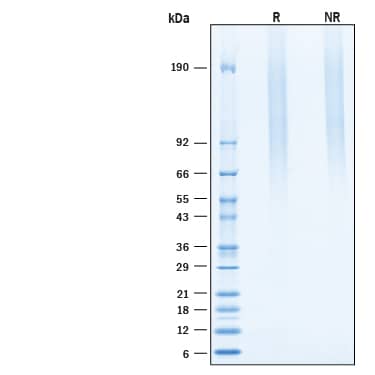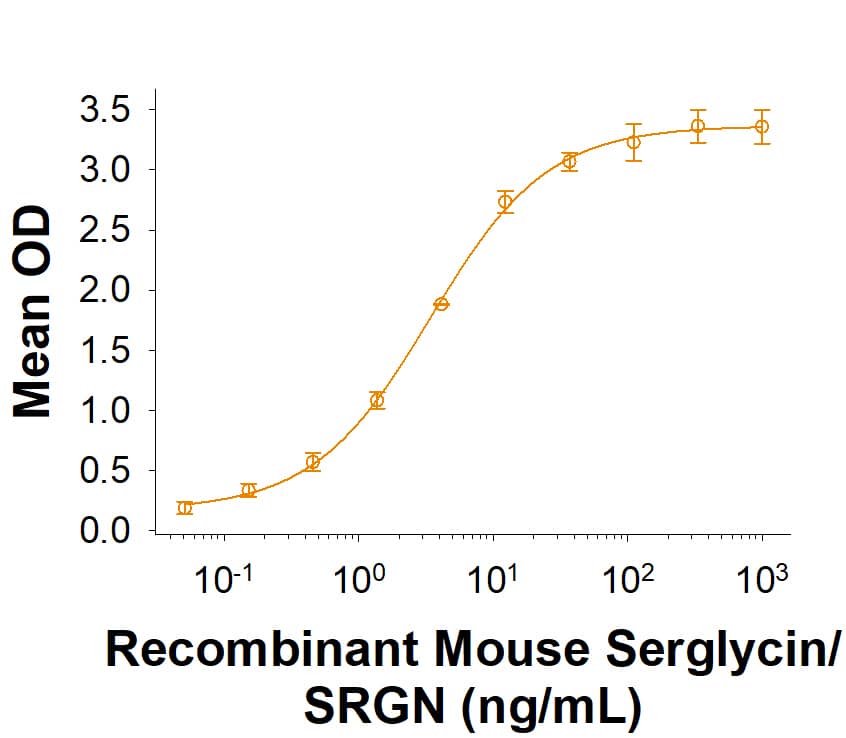Recombinant Mouse Serglycin/SRGN His-tag Protein, CF
R&D Systems, part of Bio-Techne | Catalog # 10190-SN

Key Product Details
Product Specifications
Source
Human embryonic kidney cell, HEK293-derived mouse Serglycin/SRGN protein
| Mouse
Serglycin/SRGN (Tyr26-Ile152) Accession # P13609 |
HPGGGSGGGSGGGS | HHHHHH |
| N-terminus | C-terminus |
Purity
>95%, by SDS-PAGE visualized with Silver Staining and quantitative densitometry by Coomassie® Blue Staining.
Endotoxin Level
<0.10 EU per 1 μg of the protein by the LAL method.
N-terminal Sequence Analysis
Tyr26
Predicted Molecular Mass
16 kDa
SDS-PAGE
55 kDa and above, under reducing conditions
Activity
Measured by its binding ability in a functional ELISA.
When Recombinant Mouse CD44 Fc Chimera (Catalog # 6127-CD) is immobilized at 0.5 µg/mL (100 µL/well), Recombinant Mouse Serglycin/SRGN His-tag (Catalog # 10190-SN) binds with an ED50 of 1.5-15 ng/mL.
When Recombinant Mouse CD44 Fc Chimera (Catalog # 6127-CD) is immobilized at 0.5 µg/mL (100 µL/well), Recombinant Mouse Serglycin/SRGN His-tag (Catalog # 10190-SN) binds with an ED50 of 1.5-15 ng/mL.
Scientific Data Images for Recombinant Mouse Serglycin/SRGN His-tag Protein, CF
Recombinant Mouse Serglycin/SRGN His-tag Protein Binding Activity
When Recombinant Mouse CD44 Fc Chimera (Catalog # 6127-CD) is immobilized at 0.5 µg/mL (100 µL/well), Recombinant Mouse Serglycin/SRGN His-tag (Catalog # 10190-SN) binds with an ED50 of 1.5-15 ng/mL.Recombinant Mouse Serglycin/SRGN His-tag Protein SDS-PAGE
2 μg/lane of Recombinant Mouse Serglycin/SRGN His-tag (Catalog # 10190-SN) was resolved with SDS-PAGE under reducing (R) and non-reducing (NR) conditions and visualized by Coomassie® Blue staining. Due to heavily O-linked glycosylation, it runs as a smear above 55 kDa.Formulation, Preparation and Storage
10190-SN
| Formulation | Lyophilized from a 0.2 μm filtered solution in PBS. |
| Reconstitution | Reconstitute at 500 μg/mL in PBS. |
| Shipping | The product is shipped at ambient temperature. Upon receipt, store it immediately at the temperature recommended below. |
| Stability & Storage | Use a manual defrost freezer and avoid repeated freeze-thaw cycles.
|
Background: Serglycin/SRGN
References
- Theocharis, A.D. et al. (2010) FEBS J. 277:3904.
- Kolset, S.O. and Pejler G. J. (2011) Immunol. 187:4927.
- Scully, O.J. et al. (2012) Anat Rec (Hoboken) 295: 1415.
- Abrink, M. et al. (2004) J. Biol. Chem. 279:40897.
- Grujic, M. et al. (2005) J. Biol. Chem. 280:33411.
- Zernichow, L. et al. (2006) J. Biol. Chem. 281:26792.
- Schick, B.P. (2010) Prog Mol Biol Transl Sci. 93:235.
- Toyama-Sorimachi, N. et al. (1997) J Biol Chem. 272:26714.
- Skliris, A. et al. (2011) Eur. J. Immunol. 41:437.
- Reine, T. et al. (2014) Biochim Biophys Acta. 1840:2498.
- Purushothaman, A. (2014) J. Biol. Chem. 289:5499.
- Guo, J. et al. (2017) Oncogene 36:2457.
Long Name
Hematopoietic Proteoglycan Core Protein
Alternate Names
SRGN
Gene Symbol
SRGN
UniProt
Additional Serglycin/SRGN Products
Product Documents for Recombinant Mouse Serglycin/SRGN His-tag Protein, CF
Product Specific Notices for Recombinant Mouse Serglycin/SRGN His-tag Protein, CF
For research use only
